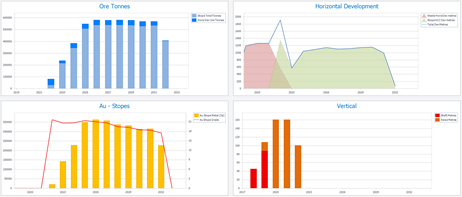Datamine Task Scheduler (DTS)
Datamine Task Scheduler (DTS) is the premier project scheduling package for the mineral extraction industries. DTS provides the ability to manage and manipulate task information in ways specifically designed for the needs of the mining industries.
Studio UG interacts with DTS via a DTS Template File.
This file is the link between the 2 applications and determines how data is interpreted to generate crosstab reports and a Gantt chart in DTS. DTS Template files are created within the DTS application and are mandatory for transferring information between DTS and Studio UG.

Data transfer is performed using the Transfer Data to panel.
Studio UG includes a very useful visualization 'bridge' that allows you to see, in 3D , which aspects of your Gantt chart relate to activities in your mine design. This is achieved using Studio UG's animation facilities, but can also be provided by a standalone application - InTouch . See Introducing InTouch DTS.
Ultimately, Studio UG and DTS can:
- Create the mine design (declines, infrastructure, access, ventilation, etc)
- Evaluate design solids against the block model (tonnage, volume and grades)
- Define how to mine (logical sequence)
- Define how much and when to mine (schedule)
Top 20 DTS Functions
-
Modify task period values in the Gantt Chart interactively in a manner similar to using a spreadsheet
-
Create user-defined physical properties, such as Tonnage, Meters and Grade (such as gold)
-
Specify Tasks as either rate or duration driven and assign scheduling constraints. Vary the rates over time
-
Customize the display of tasks and dependencies with coloring, based on user-defined text fields and layers
-
Maintain separate scheduling and reporting calendars, with the ability to report data over any given time period
-
Schedule holidays and shut-down periods, and display these in the Gantt Chart
-
Create filters to build customized views in the Gantt Chart and for Cross tab reporting
-
Filter, sort, and group tasks on any field or combination of fields including user-defined text and production fields
-
Wizards to automate creation of Task Filters and Report Calendars
-
Interactively link tasks (create dependencies)
-
Level a schedule based on resource availabilities as assigned to specific tasks. Vary the availabilities over time
-
Track actual information for tasks including dates, production fields, and percentage complete
-
Set Baselines for comparison against planned and actual performance
-
Set target ranges for all user-defined properties for production planning
-
Build basic financial plans through revenue and cost fields
-
Plan and track revenue, and fixed and variable costs over time
-
Report summarized period values using tables or histograms in the Cross tab
-
Define views of the data for fast reporting and printing
-
Seamless data integration with packages.
Related topics and activities

